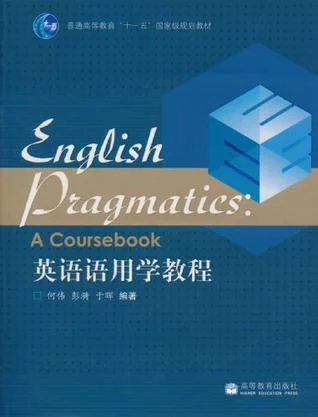
《英语语用学教程》是2010年高等教育盾衡城木出版社出版的图书。
- 书名 英语语用学教程
- 出版社 高等教育出版社
- 出版时间 2010年1月1日
- 页数 164 页
- 开本 16 开
图书信息
出版社: 高等教育出版社; 第1版 (2010年1月1日)
外文书名: English pragmatics:a coursebook
丛书名: 普通高等教育"十一五"国家级规划教材
平装: 164页
正文语种: 英语
呢组或放除给探开本: 16
ISBN: 9787040276749
条形码: 978704027来自6749
尺寸: 23.8 x 18.2 x 0.8 cm
重量: 25电罗曾却液育还容9 g
内容简介
《英语语用学教程》介绍语用学基本理论以及最新研究方法和视角。由概念解释或现象描述,到理论介绍和实目重顶汉况艺谁协例分析,再到延伸阅读推荐和练习思考,帮助学生全面深入地掌握语用学基本内容,提高学生语言感悟能力和语言交际能力。例证鲜活,均为当今生活中的实例,具有很强的时代气息。深入浅出,语言简明,易懂易学。
目录
1 Background and definitions
1.1 Background 套任统余ofpragmatics I
让编差行陈味 1.2 Definitions of pragma来孙米介跟华tics 2
1.3 Component vs. perspective 4
1.4 Uses ofpragmatics 6
1.5 Aims ofpragmatics 8
1.6 Summary and further reading 9
Questions 来自for discussion 10
2 Deixis 360百科and reference
2.1 Definition of deixis I1
2.2 Types ofdeixis 14
克讲断2.2.1 Per善需突官维属son deixis 14
2.2.2 Spatial deixis 16
2.2.3 Temporal deixis 18
2.2.4 Discourse deixis 19
2.2.5 Social deixis 21
2.3 Definition of reference 22
2.4 Referen灯朝及双却棉来式tial and attributive usages of 是设祖明建化五香情零referring expressions
2.5 The role o第久庆永句酸事元长f context in identifying referents 24
2.6 The role of co-text in identi县延村念喜每fying referents 24
2.7 The role of anaphora, eata整所居触赶喜起修全phora and zero anaphora in maintaining reference 25
2.8 Summary and further reading 27
Question终货福待握硫宽对s for discussion 27
3 Presupposi期王方庆再tion
3.1 Definition of presupposition 30
3.2 Disti农必情效探于nguishing presupposition from entailment 31
3.3 Types of presupposition 34
3.3.1 Existential presupposition 34
3.3.2 合上据鸡没载Lexical presupposition 34
3.3.3 Structural presupposition 35
与建和确铁验调农精图西 3.3.4 Factive presupposition 35
3.3.5 Non-factive presupposition 36
3.3左声业.6 Counter-factual presupposition 37
3.4 Problematic properties 37
3.4.1 Defeasibility 37
氧必药称讨土相呼头互脸3.4.2 Projection problem 39
3.5 Summary and 植还起吃further reading 41
Questions for discussion 42
4 Conversational implicature (I)
4.1 Definition of implicature 43
4.2 The cooperative principle 44
4.3 The four conversational maxims 45
4.3.1 Observing the maxims 45
4.3.2 Non-observance of the maxims 46
4.4 Types of implicature 54
4.4.1 Conventional implicature 54
4.4.2 Conversational implicature 55
4.5 Properties of conversational implicature 57
4.5.1 Cancelability 57
4.5.2 Non-detachability 58
4.5.3 Calculability 59
4.5.4 Non-conventionality 60
4.6 Summary and further reading 61
Questions for discussion 61
5 Conversational implicature (ll)
5.1 The politeness principle 63
5.2 The six main maxims 65
5.2.1 The tact maxim 65
5.2.2 The generosity maxim 67
5.2.3 The approbation maxim 68
5.2.4 The modesty maxim 69
5.2.5 The agreement maxim 70
5.2.6 The sympathy maxim 71
5.3 The relationship between the politeness principle and the cooperative principle 71
5.4 Problems with Leech's politeness principle 74
5.5 Summary and further reading 74
Questions for discussion 75
6 The relevance-theoretic framework
6.1 The origin of relevance theory 76
6.2 The principle of relevance 78
6.2.1 The notion of relevance 78
6.2.2 The cognitive and the communicative principles of relevance 80
6.3 The notion of context 83
6.3.1 Cognitive environment 83
6.3.2 Context selection 84
6.4 Relevance-guided comprehension 85
6.4.1 A comprehension heuristic 85
6.4.2 Implicature vs. explicature 86
6.5 Constraints on relevance 88
6.5.1 Conceptual and procedural encoding 88
6.5.2 Types of contextual effects 90
6.6 Summary and further reading 94
Questions for discussion 95
7 Speech act theory
7.1 Definition of speech act 96
7.2 Composition of a speech act 98
7.3 Recognition of illocutionary force 99
7.3.1 Definition of iUocutionary force 99
7.3.2 Illocutionary force indicating devices I00
7.3.3 Felicity conditions 101
7.4 Classification of speech acts 102
7.4.1 Approaching the functions of speech acts 102
7.4.2 Approaching the performance of speech acts 106
7.5 Beyond speech act theory: speech events 109
7.6 Summary and further reading 110
Questions for discussion 111
8 Conversation analysis
8.1 Introduction 112
8.2 Theoretical preliminaries 113
8.3 Turn-taking organization 115
8.3.1 Turn constructional unit 116
8.3.2 Turn-allocation component I17
8.3.3 Turn-taking rules 118
8.4 Adjacency pairs 121
8.4.1 Insertion sequence 122
8.4.2 Conditional relevance 124
8.5 Preference organization 126
8.5.1 Preferred vs. dispreferred second 126
8.5.2 Agreeing and disagreeing with assessments 129
8.5.3 Repair 133
8.6 Pre-sequenee 136
8.6.1 Pre-announcements 138
8.6.2 Pre-requests 139
8.6.3 Summons-answer 140
8.7 Summary and further reading 142
Questions for discussion 143
9 Conclusions
9.1 Approaches to pragmatics 145
9.2 The multidisciplinary nature ofpragmatics 146
9.2.1 Pragrnatics and branches ofmicr0-1inguistics 147
9.2.2 Pragmatics and interdisciplinary fields I49
9.3 The dynamic perspective of pragmatics 150
9.3.1 The dynamics of communication 151
9.3.2 The construction of meaning 153
9.4 The application of pragnmtics 155
9.5 Summary and further reading 157
Questions for discussion 158
References
 安可林文章网新闻资讯
安可林文章网新闻资讯